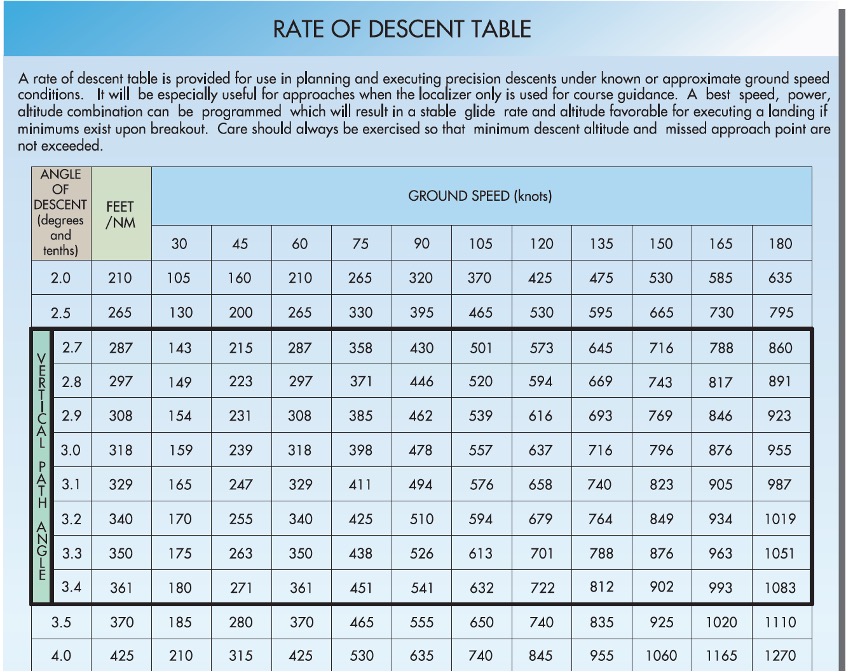Stop Chasing the Glide Slope Indicator: It’s A Race You Can’t Win
By Hank Canterbury

When “Flying by the Numbers,” you use the aerodynamic reactions of the aircraft to greatly assist in flying the plane and achieving repeatable performance. For example, in a Bonanza, setting the Manifold Pressure [MP] at 16 – 19 inches – which varies by engine horsepower, and flying level with gear and flaps up – will repeatably result in 120 KIAS.
Let’s say you also choose to maintain 120 KIAS while flying an approach to minimums. With the airplane stabilized and trimmed, when the glide slope [GS] needle centers, all you need do is extend the landing gear. The plane will dutifully lower its pitch about 3 degrees; begin a descent at the same airspeed; and shortly stabilize after a few over-and-under shoots at close to a 500 to 600-feet-per-minute descent. Now that’s nice. No forcing; no trimming needed; no power adjustments. A more positive technique is to deliberately move the nose down 3 degrees.
But what if the resulting descent rate does not keep the glide slope indicator centered? First off, most but not all IFR approaches are very close to a 3-degree descent. Looking at the table in the U.S. Terminal Procedures Publication [TPP] for descent rate versus ground speed, we see that it requires 636 feet per minute at 120 knots. Geometry requires that you descend 318 feet per mile to stay on GS. This information is also available on Jeppesen approach charts.

So far, all is good. Just keep the VSI nailed by holding the attitude constant, and soon you’ll be at minimums. Look up and there’s the runway. Ah yes, if nature were so cooperative.
Notice that the table uses ground speed for the rate needed. But winds change often with variations in altitude – and that’s exactly what happens on approaches. You may be precisely maintaining 120 knots indicated airspeed but ground speed is no longer 120. If ground speed changes, by holding the same rate you will progressively go either low or high on glide path because ground speed to touchdown is now different than 120. Wind speed and direction at the Final Approach Fix [FAF] altitude will likely not be what you have all the way to touchdown. Therefore, small corrections are usually in order.
For those of us who were taught instrument flying using the concept of “Primary and Supporting Instruments,” you may remember that on a precision approach (or constant rate climb or descent), the vertical speed indicator (VSI) is the primary pitch instrument. Supporting instruments are altimeter, airspeed and attitude. Despite a short lag, the VSI tells us most directly the pitch that we need to perform correctly.
That means in order to stay on the glide slope, we need to know the vertical speed required for the ground speed we expect on approach. It’s called Target Vertical Speed – and it is not always 500 to 600 feet per minute. Using the technique above, the plane gets us onto the glide slope near what may be about right. Then we must adjust the pitch — or vary the power — as needed to maintain the target vertical speed.
On an approach as you near the FAF, it’s unlikely you are going to grab the TPP table to look it up: You don’t have to. Here’s my go-to cockpit math to get that new number quickly. As you near the GS interception point, simply look at your ground speed read out; multiply it by 5; then add 50 feet / minute (rounds up the 18 feet above 300) to get the necessary VS to stay on glide path at that ground speed.
(120 GS x 5 = 600 + 50 = 650 feet / minute needed)
Alternatively, you can divide GS by 2, add a zero to it and then add 50 feet / minute to get the same result. In either case, the number will be very close to what is necessary.
(100 GS / 2 = 50–Add a zero = 500 +50 = 550 feet /minute needed)
After a couple of times the answers will come easily and you won’t need to haul out the table. Begin the descent as described above.
Here’s another rule of thumb to keep in mind. Change the pitch attitude you were holding when level by the same amount as the published glide slope [GS], e.g., pitch when level is +2 degrees; GS is 3 degrees; new attitude is now minus 1 degree.
Among other instruments, I keep my eye on the ground speed as I proceed downhill. When the glide slope indicator begins to stray off center, I first check two things—the actual rate I’m holding, as well as the ground speed. This helps me to interpret why the needle is not staying centered. It’s most likely that one or both of those variables are not what I initially determined.
I’ve observed some big changes in winds while on final, even including a reversal of direction! So now adjust pitch attitude or power to achieve the new vertical speed needed. Don’t “chase” the glide slope needle by making imprecise attitude corrections. Change the aircraft pitch or power a discrete amount to achieve your new VS target and then be patient. As a cowboy said, “let’s cut ‘em off at the pass.” Here’s how to do that.
When pilots perceive they are not descending at the correct rate to keep the needle centered, they will quickly make some pitch change in the correct direction needed, but usually far too large. Shortly, the needle goes the other way, and up and down you go.
Here’s another simple math trick to grasp just how much one degree of pitch attitude change makes in vertical rate. Knowing the resulting magnitude of a given pitch attitude change will greatly reduce overcontrolling, especially when only small, precise adjustments are needed.
For example, if I notice I’m going below the GS at 800 feet /minute when I should be holding 600 feet /minute, I only need to change the attitude by ONE degree to reestablish 600 feet / minute. To recapture the GS, it may take 2 degrees of change (and hold it a few seconds) to climb back up to the GS (head toward the pass) before reducing pitch ONE degree.
Here’s how to figure out the magnitude of a pitch change. Divide your airspeed by 60 to get miles-per-minute. To be more precise, use true airspeed [TAS], but in most cases indicated air speed [IAS] is close enough without further complexity. The math works better using knots instead of mph. Then multiply by 100 to see how much each degree of pitch attitude change will make in vertical speed. This assumes we are talking about relatively small angles here (< 5 degrees) and airspeed remains close to the starting speed.
(90 kts/60 = 1.5 x 100 = 150 feet per degree of pitch change)
Older attitude instrument presentations (“steam gages”) are often so compressed, it’s difficult to make small changes. Glass panels have expanded scale from older gages, thus making it easier to see and make more precise movements. In either event, if you know how many degrees you are trying to change, you will come closer to getting it right than not.
As you approach the glide slope intercept, develop the habit of noting your GS and compute the Target Vertical Speed. Then at the glide path intercept, change the pitch attitude 3 degrees from whatever it was to establish a descent. Remember, provided you are stable and trimmed at this time, by putting the gear down, the plane’s aerodynamic stability characteristics will automatically lower the nose about 3 degrees, yielding ~600 feet / minute for you without any power changes. Thereafter you just make small adjustments to maintain the target rate. These simple computations work for any glide path and speed you choose.

At first, these cockpit mental math tricks may seem like so much minutia when you’re busy, but if you start to use them you will be pleasantly surprised how much more accurately and easily you fly instruments. You’ll know what it takes to stay on glide path, as well as how much pitch adjustment is required to create changes in the descent rate, if needed.
Few of us can keep the needles centered all the time. Instrument flying is really a continuous series of small adjustments and iterations. Never give up: it’s rewarding — and a good autopilot is a delight.
Fly Often – Train Regularly –Practice More!
Hank Canterbury
ATP, CFII SEL & MEI
Flyf33@aol.com



